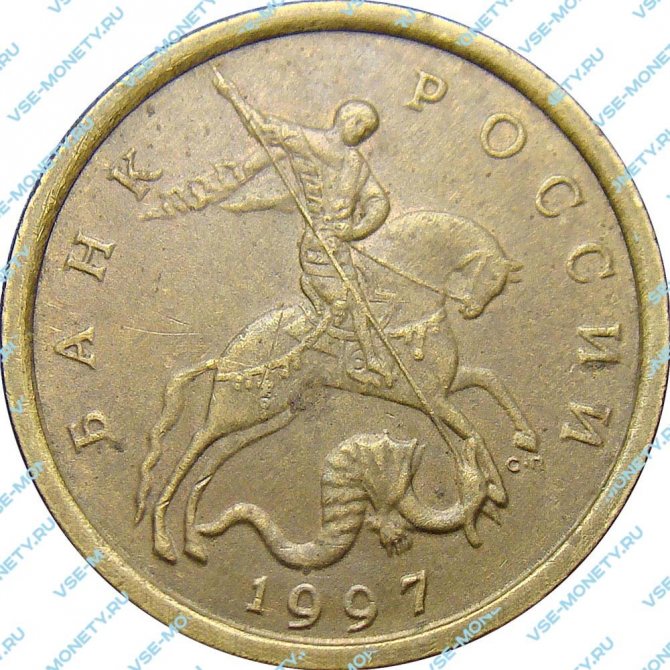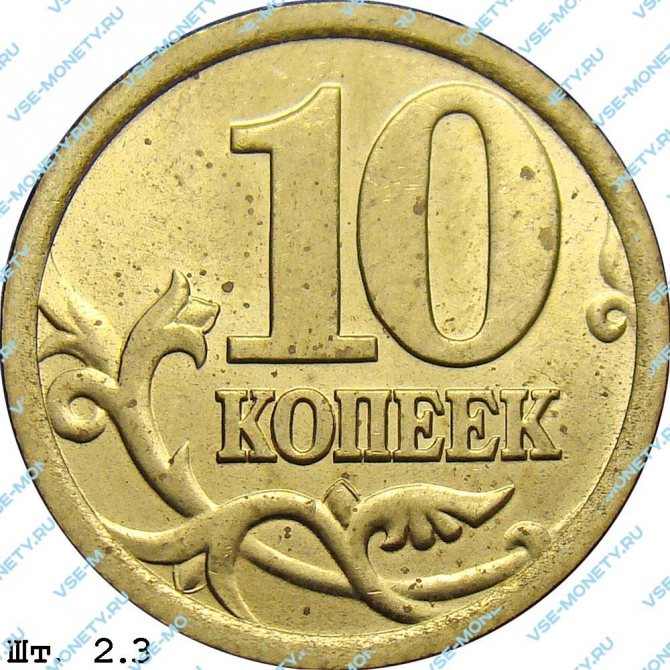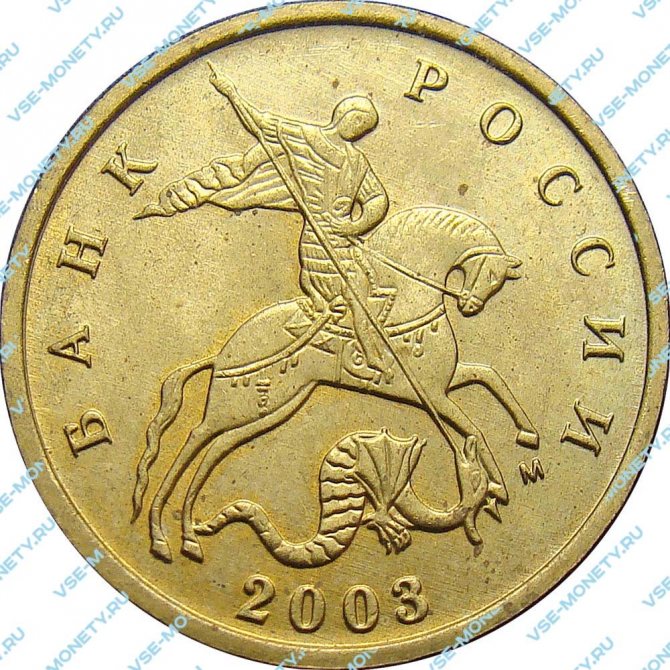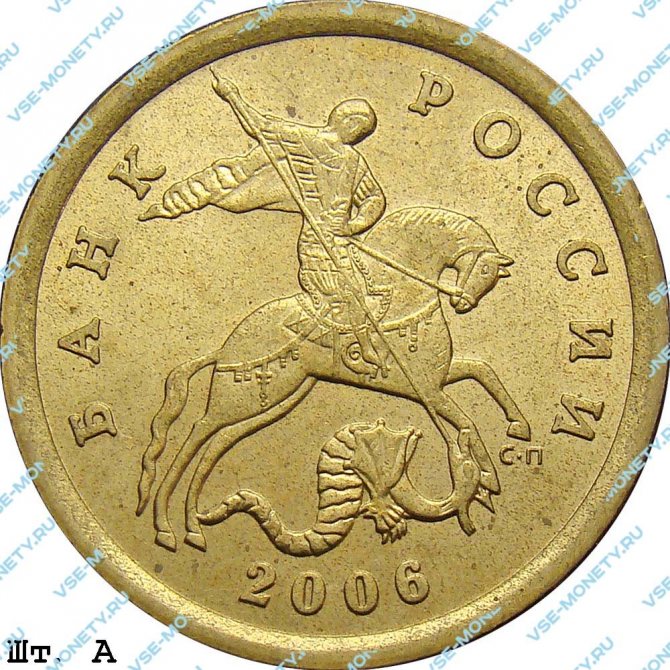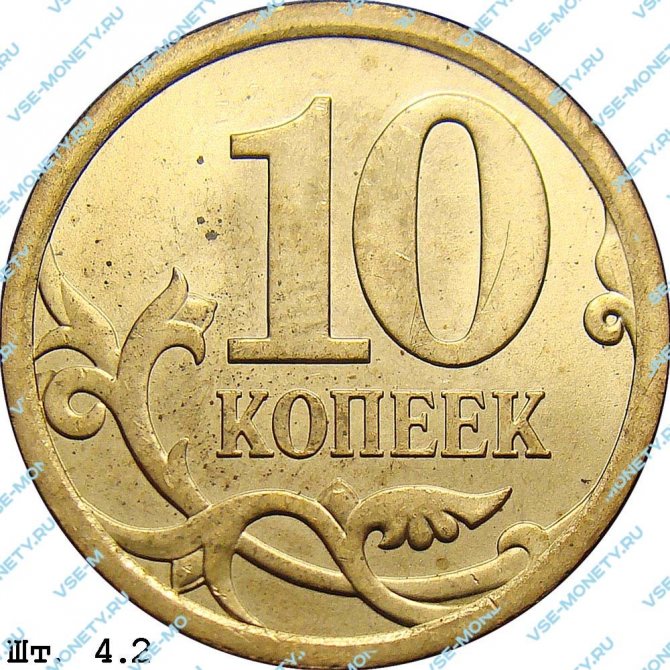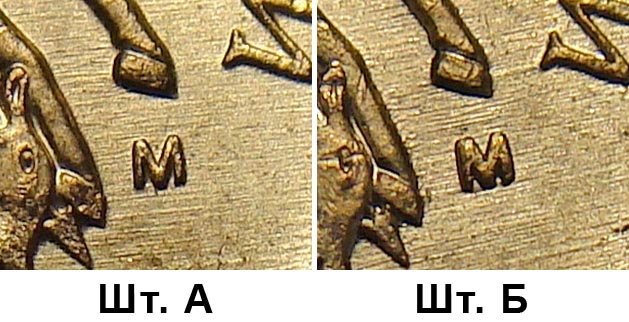Greetings to all readers!
23 years have passed since the denomination of the ruble and the introduction of updated banknotes into circulation.
Despite the relatively long period, it is too early to call the 1997 coins rarities. They are still found among the change, since they were minted in huge quantities, with a reserve for the future.
It is difficult to find them in good condition, so on trading platforms unremarkable coins are sometimes sold for hundreds of times more than their face value.
But among the 1997 edition there are non-standard varieties that can cost even more even for less-than-ideal preservation. For this reason, it makes sense to take a closer look at the details.
Rare years and varieties
The problem with finding expensive varieties is that all their differences are microscopic. Therefore, you have to take photos of each specimen and view them on the monitor screen at multiple magnification. You can also use an electron microscope for this purpose. Below we will talk only about those rare varieties that stand high and at the same time have obvious signs that are understandable even to beginners in the world of numismatics. You will find information about all other options in the catalog of varieties of coins with a denomination of 1 ruble.
1997 - price up to 8,000 rubles.
Among the rubles of 1997, we are looking for 1 ruble MMD with a wide edge. Learn more about mint marks on modern coins. We look at the reverse (the side without the eagle). If the leaf is partially hidden under the protruding edge of the coin, then this is an expensive variety with a wide edge. The edging itself can be with or without a step. This option with a wide edging costs an average of 2 to 8 thousand rubles.

It’s also worth choosing this year’s coins with stamp shine from your piggy banks. If the ruble has lain untouched since 1997 and has retained its minted shine, then it will cost from 100 rubles. up to 1.5 thousand rubles.
1998 - cost up to 3,000 rubles.
We choose 1998 MMD rubles with a wider edge. They should be distinguished in this way: we turn the eagle away from ourselves, look at the plants; at the wide edge there is no opening between the leaf (see photo) and the protruding strip along the edge. A valuable copy will cost from 1.5 to 3 thousand rubles.
1999 - up to 300 rubles.
If you take the search process seriously, then anyone can find these 1999 rubles. They (neither MMD nor SPMD) are very rare, but still cost more than their face value. Worn copies will cost up to 30 rubles.
There are also anniversary issues of 1999 with Pushkin. Even with minor scratches (in far from ideal condition), they go at auction for 200-300 rubles.
2001 - up to 300,000 rubles.
It is worth knowing that a couple of one-ruble coins from 2001 were previously found. Maybe over time there will be more copies of this year somewhere. Prices for such rarities have increased greatly in recent years; they are estimated at 2-3 hundred thousand rubles.
But it’s still better to turn your attention to this year’s anniversary issue, dedicated to the 10th anniversary of the CIS. For such a coin they can offer you up to 300 rubles.
2002 - 9,000 rubles.
The 2002 rubles were issued as part of sets of coins from the St. Petersburg and Moscow mints. Individually, such rubles cost 8-9 thousand per copy, and the entire set is estimated at 20-30 thousand rubles.
The photo shows one of the annual coin sets:

Should I look for 2002 coins? Imagine the following situation. A collector purchases an annual set in a colorful blister at an auction for 25 thousand, and then cuts it up and pays with valuable banknotes in collectible condition somewhere in a store. Is this possible? No! Of course, they say that someone has already found rubles from such sets in circulation, but there have always been many legends in Russian numismatics.
2003 - up to 300,000 rubles.
In 2003, they wanted to issue coin sets similar to last year, but something did not work out for the Bank of Russia. The St. Petersburg factory even minted 15 thousand coins of each denomination, but the finished sets were not released. The rubles remained in warehouses for some time, and then were put into circulation. A decent number of them have already been found, but still not all of them. They already cost up to 30 thousand and prices continue to rise.
But the story about this coin would be incomplete without telling us that recently they began to talk about the existence of a 2003 coin with the symbols of the Moscow Mint - MMD. It is tentatively estimated at 300,000 rubles.
2005 - up to 5,000 rubles.
There are rare varieties among 2005 that are expensive, but identifying them will be very difficult. If you want to explore such complex options, then look at a separate article dedicated to the 2005 ruble. But the ordinary varieties of this year do not have any value.
2006, 2007, 2008, 2009, 2010
You should not look for particularly valuable options among coins from these years of issue. However, it is worth mentioning that since mid-2009, rubles have become magnetic (before that time, the billets were copper-nickel, and after that they became steel). This point will be important in the subsequent part of the review.
We will separately highlight SPMD rubles for 2009 and 2010. Most catalogs and price tags indicate that their cost is 50-100 rubles, but on various trading platforms on the Internet there are offers to sell these “infrequent” coins at a price of 4 rubles. Therefore, you should not count on big profits from these banknotes; it is better to put them aside for a while.
2011 - 2012 - up to 300,000 rubles.
During these years, rubles were minted en masse only by the Moscow Mint. And SPMD in 2011 and 2012 released only a few copies as samples, which became one of the most valuable coins of modern Russia (price about 300 thousand rubles).
2013, 2014, 2015
You should not look for rare and valuable options among these model years.
2016 - up to 300,000 rubles.
The situation is similar to the previously described years 2011 and 2012. SPMD does not participate in mass minting, but from photos on the Internet, numismatists learn that the St. Petersburg factory nevertheless produced one or two copies of coins with a denomination of 1 ruble. The 2021 rarity costs about 300 thousand rubles.
2017, 2021 and 2019
These years have not yet been sufficiently studied. It is possible that valuable varieties will be identified in the future.
How much do modern 10 kopecks cost?
According to numismatic catalogs and price tags, modern 10 kopecks in excellent condition cost from 1 to 20 rubles. If excellent preservation (UNC) is combined with stamp shine, then non-magnetic tens of the first years of issue often cost several hundred rubles at auction, and individual lots can be valued at 1,000 rubles. For example, in 2021, a ten-kopeck coin issued in 1997 was valued at 935 rubles at auction.

These brilliant lots are so valuable because each year it becomes increasingly difficult to find perfectly preserved examples for the collection. In addition, specimens from trial batches, infrequent and rare varieties, as well as various mix-ups and defects are expensive.
Valuable types of defects and mint errors
A large number of numismatists collect defective coins, so finding a buyer for rare types of defects is not difficult. And the cost will depend on the uniqueness of the defect; combinations of defects, as well as their extreme manifestations, are most highly valued.
A few examples:
1
. Defective stamp blockage. Sold for 360 rubles.
2
. Marriage “complete split”, issue 2011. Priced at 400 rubles.
3
. Defect “workpiece displacement” (release date - 2008). The selling price was 401 rubles.
4
. Marriage is a 180 degree turn. Such a defect went away for 800 rubles.
Mint errors and experiments
Looking at the results of auctions held in recent years, you can find an increase in the number of lots with various errors, as well as mixed-up coins. For example, these are rubles with two obverses or two reverses, or copies minted on different blanks. Non-magnetic mugs (which were used until 2009) can be used as blanks for rubles from recent years of issue. They can be minted on circles of 50-kopeck coins, or bimetallic blanks of unknown origin can be used. There has been plenty of variety in recent years.
Can these described coins be attributed to a marriage? Numismatists have not reached a consensus. Most of these examples cannot be explained by any error in production; they could only appear as a result of someone’s commercial intent. Therefore, their cost is reduced. Previously, such unique money was estimated at 20-30 thousand, but now buyers often refuse to place bids on such lots for more than 10 thousand rubles.
Rare coins
The next two coins are the most valuable of all 10 kopecks in modern Russia. Their high price is justified by their rarity.
In 2011 and 2012, the SPMD did not produce regularly minted metal banknotes, but a few examples from these years did surface at auction. It is believed that this was a trial release. The table below shows the catalog value of these coins:
| Year | Mint (letters) | Price, in rub. |
| 2011 | JV | 150 000 |
| 2012 | JV | 150 000 |
Valuable varieties
Varieties are coins of the same year, struck at the same mint, but still have differences. For example, there may be very small differences in the position or size of mint marks. Some varieties are less common, then their price can rise to several thousand rubles.
For example, the most famous variety of 10-kopeck coins is the 2001 variety with the letters “SP” and transverse folds on the cloak. Its price is about 3 thousand rubles.
In the photo, the difference between the rare and common varieties is 10 kopecks. 2001 JV:

There are also valuable varieties among the releases of the following years: 2002, 2003, 2004, 2005, 2007, 2010. Some of them are valued at 15,000 rubles.
Catalog by A. Stashkin: 10 kopecks 1997-2015
04/16/2020 posted by Administrator with
Alexander Stashkin's catalog has truly become a basic guide to the varieties of modern Russian coins. Below is an original fragment of the catalog dedicated to 10 kopeck coins issued from 1997 to 2015.
To visually separate the varieties of coins according to A. Stashkin’s catalog, the following designations are used:
| _____ | – private |
| – infrequent | |
| – rare | |
| – very rare | |
| – “unique” (known in one or more copies) | |
| – typesetting (found in sets, may accidentally end up in circulation) | |
| – rare coin not out of circulation |
| N | Designation | Description of reverses | Photo | Description of obverses | Photo | Red. | |
| Metal: brass (LMts58-2) Weight: 1.95 g Diameter: 17.50 mm Thickness: 1.25 mm Edge: 98 corrugations | |||||||
| 10 kopecks 1997 s-p | |||||||
| 1 |
|
| Row. | ||||
| 10 kopecks 1997 m | |||||||
| 2 |
| Row. | |||||
| 10 kopecks 1998 s-p | |||||||
| 3 | Row. | ||||||
| 10 kopecks 1998 m | |||||||
| 4 |
| Row. | |||||
| 10 kopecks 1999 s-p | |||||||
| 5 |
| Row. | |||||
| 10 kopecks 1999 m | |||||||
| 6 |
| Row. | |||||
| 10 kopecks 2000 s-p
| |||||||
| 7 | A | Vertical folds on the rider's cloak (piece A) |
| Row. | |||
| 8 | B | Horizontal folds on the rider's cloak (piece B) |
| Row. | |||
| 10 kopecks 2000 m | |||||||
| 9 |
| Row. | |||||
| 10 kopecks 2001 s-p
| |||||||
| 10 | A | Horizontal folds on the rider's cloak (piece A) |
| Row. | |||
| 11 | B | Vertical folds on the rider's cloak (piece B) | Very good rare | ||||
| 10 kopecks 2001 m | |||||||
| 12 | Row. | ||||||
| 10 kopecks 2002 s-p
| |||||||
| 13 | 1 | The lower bud is not edged, the inner walls of the zero are straight, the central parts in the letters “E” are massive (piece 1) | Row. | ||||
| 14 | 2.3 | The lower bud is edged, the inner walls of the zero are curved, the central parts in the letters “E” are thin (pcs. 2.3) |
| Red. | |||
| 10 kopecks 2002 m
| |||||||
| 15 | A | The letter is thick, close to the hoof (piece A) | Row. | ||||
| 16 | B | The letter is thin, close to the hoof, turned counterclockwise relative to the piece. A (piece B). 2 minor variants are known (pieces B1 and B2) |
| Red. | |||
| 17 | IN | The letter is thin, distant from the hoof, turned counterclockwise relative to the piece. A (piece B) | Red. | ||||
| 10 kopecks 2003 s-p
| |||||||
| 18 | 1 | The lower bud is not edged, the inner walls of the zero are straight, the central parts in the letters “E” are massive (piece 1) | There are 2 known minor variants (pieces A and B) |
| Row. | ||
| 19 | 2.1 | The lower bud is edged, the inner walls of the zero are curved, the zero is distant from the edge, the curl touches the edge, the crossbars in the inscription are long (pcs. 2.1) |
| Red. | |||
| 20 | 2.2 | The lower bud is edged, the inner walls of the zero are curved, the zero is distant from the edge, the curl touches the edge, the crossbars in the inscription are short (piece 2.2) |
| Red. | |||
| 21 | 2.3 | The lower bud is edged, the inner walls of the zero are curved, the zero is close to the edge, the curl is adjacent to the edge (piece 2.3) | Row. | ||||
| 10 kopecks 2003 m | |||||||
| 22 |
| Row. | |||||
| 10 kopecks 2004 s-p | |||||||
| 23 |
| Row. | |||||
| 10 kopecks 2004 m
| |||||||
| 24 | A | The letter is close to the hoof (piece A). 2 minor variants are known (pieces A1 and A2) | Row. | ||||
| 25 | B | The letter is distant from the hoof (piece B) | 2004 m B | Red. | |||
| 10 kopecks 2005 s-p
| |||||||
| 26 | A | The letters “PE” are close together, the edging of the lower bud does not extend beyond the edging (item 2.3). 2 minor variants are known (pieces 2.31 and 2.32) | The letters are large, the inscriptions are close to the edge (piece A) |
| Row. | ||
| 27 | B | The letters are small, the inscriptions are distant from the edge (piece B) |
| Nech. | |||
| 10 kopecks 2005 m
| |||||||
| 28 | A | The letter is raised towards the hoof and shifted to the left (piece A) |
| Row. | |||
| 29 | B | The letter is lowered and shifted to the right (item B). 4 minor variants are known (pieces B1, B2, B3 and B4) |
| Red. | |||
| 10 kopecks 2006 s-p
| |||||||
| 30 | S-2.3A | The hole in the nose is wide, the lower bud is rounded, the inscription is large (pcs. 2.3) | Large letters (pcs. A) |
| Row. | ||
| 31 | S-2.3B | Small letters (pcs. B) |
| Nech. | |||
| 32 | S-3A | The hole in the hole is narrow, the lower bud is triangular in shape, the inscription is small (pcs. 3) |
| Large letters (pcs. A) | Row. | ||
| 33 | S-3B | Small letters (pcs. B) | Row. | ||||
| 10 kopecks 2006 m | |||||||
| 34 | WITH | There are 2 known minor variants (pieces A and B) |
| Row. | |||
| Metal: steel clad with brass (L90) Weight: 1.85 g Diameter: 17.50 mm Thickness: 1.25 mm Edge: smooth, exposed steel base | |||||||
| 10 kopecks 2006 s-p | |||||||
| 35 | ON | Large letters (pcs. A) | Row. | ||||
| 36 | N-B | Small letters (pcs. B) | Row. | ||||
| 10 kopecks 2006 m
| |||||||
| 37 | N-1 | The lower bud is not edged, the inner walls of the zero are straight, the letters of the inscription are massive (pcs. 1) | Row. | ||||
| 38 | N-4.1 | The lower bud is edged, the inner walls of the zero are curved, the letters of the inscription are thin (piece 4.1) |
| Nech. | |||
| 10 kopecks 2007 s-p
| |||||||
| 39 | 3 | The letters of the inscription are wide, the curl and the blade of grass are adjacent to the edging, the edging of the lower bud is narrow (pcs. 3) |
| Row. | |||
| 40 | 4.2 | The letters of the inscription are narrow, the curl and blade of grass touch the edge, the edging of the lower bud is wide (piece 4.2) |
| Row. | |||
| 10 kopecks 2007 m | |||||||
| 41 | 1A | The lower bud is not edged, the inner walls of the zero are straight, the letters of the inscription are massive (pcs. 1) | The letter is raised, the inscriptions are close to the edge, the edge is wide (piece A) |
| Nech. | ||
| 42 | 4.1A | The lower bud is edged, the inner walls of the zero are curved, the letters of the inscription are thin, the edge is wide (piece 4.1). There are 2 minor variants known (pieces 4.11 and 4.12) | Row. | ||||
| 43 | 4.1B | The letter is lowered, the inscriptions are close to the edge, the edge is wide (piece B) |
| Row. | |||
| 44 | 4.3B | The lower bud is edged, the inner walls of the zero are curved, the letters of the inscription are thin, the edge is narrow (piece 4.3). 2 minor variants are known (pieces 4.31 and 4.32) |
| Red. | |||
| 45 | 4.3V | The letter is lowered, the inscriptions are distant from the edge, the edge is narrow (w. H). There are 5 known minor variants (pieces B1, B2, B3, B4 and B5) |
| Row. | |||
| 10 kopecks 2008 s-p | |||||||
| 46 |
| Row. | |||||
| 10 kopecks 2008 m
| |||||||
| 47 | A | The inscriptions are distant from the edge, the edge is narrow (piece A). 2 minor variants are known (pieces A1 and A2) |
| Row. | |||
| 48 | B | The inscriptions are close to the edge, the edge is wide (piece B) | Nech. | ||||
| 10 kopecks 2009 s-p | |||||||
| 49 |
| Row. | |||||
| 10 kopecks 2009 m | |||||||
| 50 |
| Row. | |||||
| 10 kopecks 2010 s-p | |||||||
| 51 |
| Row. | |||||
| 2010 m
| |||||||
| 52 | A | The saddle is edged with dots, the letter is thin, shifted to the left (piece A) | Row. | ||||
| 53 | B | The saddle is edged with lines, the letter is thick, shifted to the right (piece B). 6 minor variants are known (pieces B1, B2, B3, B4, B5 and B6) | Red. | ||||
| 10 kopecks 2011 s-p | |||||||
| 54 | 2011 s-p | Not arr. | |||||
| 10 kopecks 2011 m | |||||||
| 55 |
| Row. | |||||
| 10 kopecks 2012 s-p | |||||||
| 56 | 2012 s-p | Not arr. | |||||
| 10 kopecks 2012 m | |||||||
| 57 | A | The letter is larger, lowered and shifted to the left, the date numerals are thin (piece A) |
| Row. | |||
| 58 | B | The letter is smaller, raised and shifted to the right, the date numbers are thick (piece B) |
| Row. | |||
| 10 kopecks 2013 s-p | |||||||
| 59 | 2013 s-p | Row. | |||||
| 10 kopecks 2013 m | |||||||
| 60 |
| Row. | |||||
| 10 kopecks 2014 m | |||||||
| 61 | P-A | On a clad blank | Narrow edging (piece A) | 2014 m A | Row. | ||
| 62 | P-B | The edge is very wide, the letter is lowered (item B). Obverse stamp from 1 kopeck 2014 m | 2014 m B | Not arr. | |||
| Metal: steel (08Yu) with brass (L75) electroplating Weight: 1.85 g Diameter: 17.50 mm Thickness: 1.25 mm Edge: smooth, steel base is not visible | |||||||
| 10 kopecks 2014 m | |||||||
| 63 | G-A | On galvanized workpiece | Narrow edging (piece A) | 2014 m A | Row. | ||
| 10 kopecks 2015 m | |||||||
| 64 | On galvanized workpiece |
| Row. | ||||
The reverse, as a rule, has a characteristic lack of embossing around the perimeter of the image. This feature is a consequence of the use of a smaller diameter stamp for the obverse coinage.
How much do 10-kopeck coins cost: table of values by year
10-kopeck coins were issued until 2015 inclusive. They differ in the year of manufacture, which is indicated on the front side (obverse). Also on the obverse you can find the letters SP or M, which are associated with the place of minting. 10 kopecks that came out of the assembly line of the Moscow Mint have the letter “M”. And the St. Petersburg enterprise used stamps with the letters “SP” in its work.
The letters indicating the mint are located under the horse's front hooves:

The letters M (left) and SP (right) on coins indicating the place of minting
The table shows the cost by year, as well as taking into account mint marks:
| Year | M | JV |
| 1997 | 10 | 10 |
| 1998 | 10 | 10 |
| 1999 | 10 | 10 |
| 2000 | 10 | 10 |
| 2001 | 10 | 10 |
| 2002 | 5 | 5 |
| 2003 | 5 | 5 |
| 2004 | 1 | 1 |
| 2005 | 1 | 1 |
| 2006 | 1 | 1 |
| 2007 | 1 | 1 |
| 2008 | 1 | 1 |
| 2009 | n | 5 |
| 2010 | n | 5 |
| 2011 | n | 150000 |
| 2012 | n | 150000 |
| 2013 | n | n |
| 2014 | n | – |
| 2015 | n | – |
All prices are given in rubles. They will be exemplary for circulation copies in good to excellent condition. The letter “n” means that such a coin was not issued.
The table shows that the most expensive and valuable 10 kopecks in modern Russia are copies of 2011 and 2012 with the letters “SP”. Their high value is due to their rarity. In total, no more than 10 copies of such coins are known. They are not in circulation. All the few coins were issued for experimental purposes (it is also believed that they were minted to please collectors willing to pay high prices for rarities).
Please note that prices are for circulating copies, but similar coins in excellent condition can be valued much higher.
For example, 10 kopecks. 1997 in exceptionally good condition with a well-defined stamp sheen often cost more than 500 rubles, and individual lots are valued by collectors even over 900 rubles.
Photo of expensive 10 kopecks. 1997 in holder (without traces of circulation):


